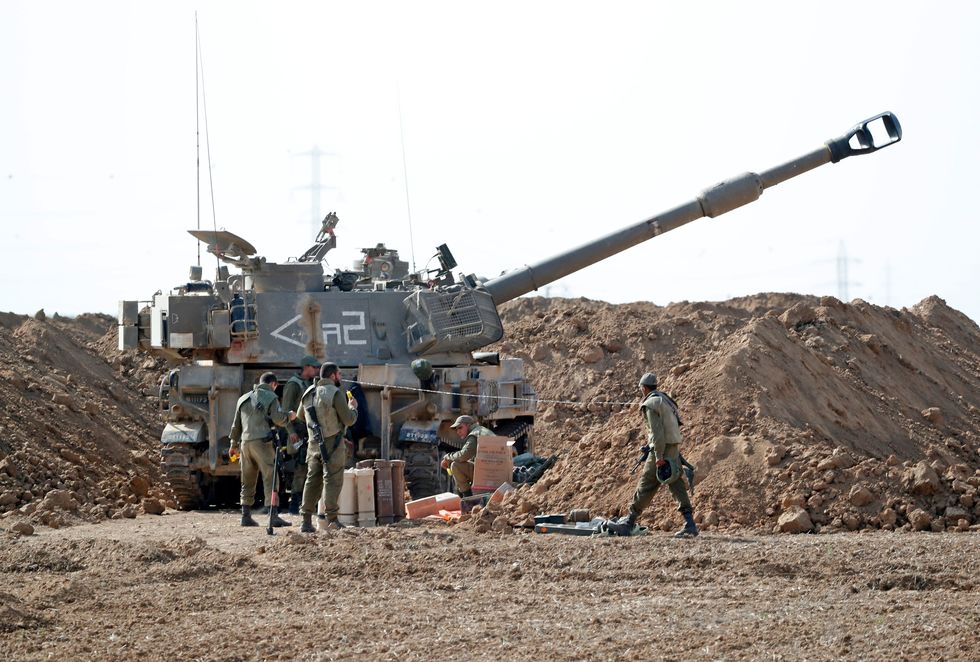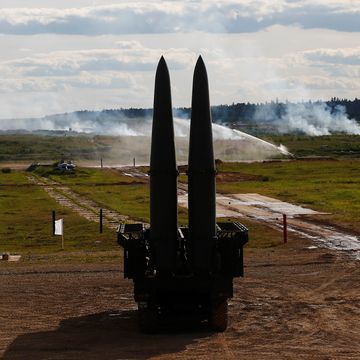- The U.S. Army is developing a super long range gun. How long? Try over 1,000 miles.
- The Strategic Long Range Cannon (SLRC) resembles the 20th century guns used to bombard battlefields from miles away.
- The new gun will likely be used to destroy enemy defenses from long range, opening the door for friendly ships and planes.
Leaked images of the U.S. Army’s new super gun have emerged on social media, showing for the first time the mysterious new weapon with a claimed range of over 1,000 miles. The Strategic Long Range Cannon (SLRC) is designed to be transported by truck, handled by a crew of eight, and rain shells down on enemy positions across continents and oceans.
The images, seen above, were apparently taken from an Army Futures Command booth at an unknown event. One image shows a very large gun being hauled by one of the Army’s M1070 Heavy Equipment Transporter Trucks. The M1070 is used to haul M1A2 Abrams tanks around, so this is a very, very gun. It is lifted in the rear by a 6x6 trailer mount.
This is the first time a rough size has been assigned to the SLRC. The M01070 is 27 feet long, so if the image is correct, the cannon base looks about 40 feet long and the entire weapon, from tail to barrel, looks about 70 feet long. The image may not be correct, however, as the gun itself looks antiquated—in fact, it looks like the US Army Model 1888 12-inch railway gun. Two other grainier photos show a lattice-like support system supporting what is probably the real gun from the base on four sides.
If the Army is using images of a 19th century gun for a 21st century weapon, that’s not really a surprise. Long range guns, moved by railroad and later heavy truck, gradually fell out of favor in the Atomic Age. The range of such guns hit a dead end, while smaller, lighter-caliber guns were developed that could fire farther. Smaller, more mobile, fast-firing guns could saturate a target with a greater weight in shells than a slow-moving, slow-shooting big gun, and were agile enough to stay out of the way of nuclear weapons.
This brings us to the mystery of the SLRC: How exactly does it propel an explosive shell more than a thousand miles? Barrel length and increasing the amount of propellant powder is typically the way to increase range, but at a certain point, engineers hit a limit as to how much they can pack in, and gun barrel steel reaches a similar—and dangerous—tolerance limit.
In the 1960s, designers began looking at modifying artillery shells themselves to increase range. This included rocket assisted projectile (RAP) shells, which incorporate rockets in the base of shells, or so-called “base bleed” technology that ejects a gas behind the shell, making it more aerodynamic overall.
The Army’s last big gun was the 280-millimeter M65 “Atomic Annie” gun. The M65 was designed to sling nuclear warheads downrange, but despite its size, it was limited to ranges of just 20 miles. Neither base-bleed or rocket technologies are sufficient to account for the 1,000-mile range of the SLRC.
What gives the SLRC its nearly magical range? One likely solution is ramjet technology. Ramjets are air-breathing engines that use the projectile’s forward motion to shovel air into an intake and then into a combustion chamber, providing a lot of oxygen for fuel and propelling the projectile along at speeds from Mach 3 to Mach 6. Because the ramjet uses available air as fuel, it needs less stored fuel and makes for a smaller overall package. Recently, Norway’s Nammo corporation announced it was developing a 155-millimeter artillery shell with a ramjet engine, quadrupling the shell’s range from 15 to 60 miles.
Does the SLRC projectile (or “projo,” as engineers call it) use a ramjet engine? Right now, it’s the only thing that makes sense. Artillery shells are fairly compact objects, and there’s not much room for a fuel supply. It makes sense to use a propulsion system that uses the fast-moving air surrounding the projectile as a fuel source.
There's another technology that's almost certainly built into the SLRC projo: GPS guidance, ensuring accuracy of less than 10 meters with each shot. Big guns are notoriously inaccurate, and there wouldn’t be much point of building SLRC if the shells missed by a half mile or more. The shell probably includes technology borrowed from the 155-millimeter Excalibur howitzer shell, which can hit targets—now including moving targets—with pinpoint accuracy.
The Army plans to use the SLRC to blast enemy defenses during wartime, firing in batteries of four at a time to blast enemy headquarters units, air defense sites, radars facilities, supply dumps, and more. All of this destruction would batter the enemy’s command and control, air defense, and sea defense networks, paving the way for the Air Force and Navy to follow.
The big question: Will this actually work?
Squeezing a range of greater than 1,000 miles from a platform that in the past could achieve only 20 miles would be a mind-bending achievement. Nothing remotely like it has ever been done before, and there's some skepticism that the Army can really back up the claim. Until the system is tested, we really won't know for sure.
The 1,000-mile range of SLRC opens up some intriguing uses: from southern Germany, the Army could land shells on the outskirts of Moscow. From the Philippines, the Army could pound China’s artificial islands—and the missile sites and airfields on them—to pieces. From Japan, SLRC could hit Beijing itself.
SLRC can hold a huge number of targets at risk without putting a single fighter or bomber pilot into the air, flying under missile defenses to strike targets across oceans on the first salvo. It’s ironic that one of the most innovative weapons in the Army’s development process is one that the service basically gave up on in the 1960s. It’s back to the future for the U.S. Army.
Source: Interesting Engineering

Kyle Mizokami is a writer on defense and security issues and has been at Popular Mechanics since 2015. If it involves explosions or projectiles, he's generally in favor of it. Kyle’s articles have appeared at The Daily Beast, U.S. Naval Institute News, The Diplomat, Foreign Policy, Combat Aircraft Monthly, VICE News, and others. He lives in San Francisco.















